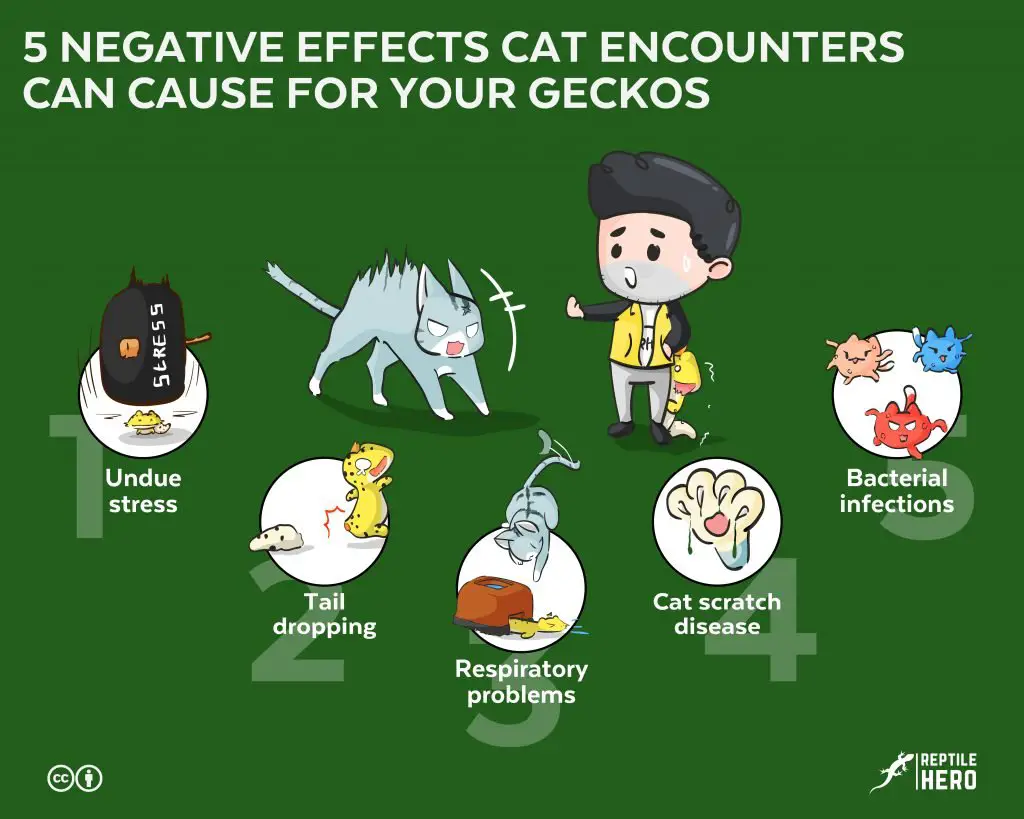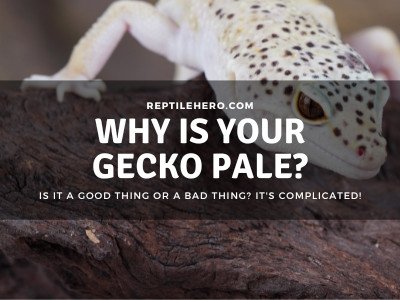Can You Have a Gecko and a Cat Together? [Yes, But…]
No matter how cute and fluffy your cat is, these furballs have razor-sharp claws and piercing teeth. Pair that with a gecko’s relatively thin and vulnerable skin and you’ll find yourself regretting ever letting cats and gecko meet—or even play.
In general, geckos and cats can live in the same house however they should never directly meet and ideally, they should live in separate rooms of the house. Cats can get really aggressive towards geckos that can suffer from 1) stress, 2) tail dropping, 3) breathing issues, 4) serious injuries, and 5) infections due to cats. Conversely, cats might get 1) injuries, 2) liver flukes, and 3) salmonella from geckos.
Did you know that a simple cat scratch can not only bring you to the hospital bed but also your gecko to its death bed? Despite constantly grooming themselves, cats actually hide a dirty little secret under their claws—read on to find out what it is!
5 Negative Effects Cat Encounters Can Cause for Your Geckos
Needless to say, presenting your gecko, a naturally small and vulnerable prey, to your cat is a recipe for disaster. All cats—indoor, free-ranging, stray, and feral felines—have been documented to not only attack but also feed on geckos and a large variety of other small wildlife [1, 2].
Even the softest and laziest kitties are guilty of this simply because they have innate predatory instincts.
So if you have any plans of keeping scaly and furry babies in the same household, familiarize yourself with all the possible risks. I would also strongly advise you to have the details of an experienced veterinarian for your pets handy at all times, plus money to spend for potential emergency visits.
There are 5 negative effects of letting a cat continuously bother a gecko:
- Undue stress
- Tail dropping
- Respiratory problems
- Cat scratch disease
- Bacterial infections
The combination of all these can subsequently result in your gecko’s untimely demise.
Warning: Do take note that even if your geckos are always in their tanks and never let out to interact in close proximity with your cat—with or without supervision. Your gecko may still experience these things as long as your cat has access to the tank. So make sure to take the necessary safety precautions to protect your geckos against cat attacks.
Check our full guide on how to prevent your gecko and cat from having bad encounters here.

#1—Undue Stress
Even in the absence of direct contact, a gecko can undergo severe stress if it is being forced to meet with and constantly being watched by much bigger animals such as cats [3]. Chronic stress greatly compromises a gecko’s immune system, rendering it more prone to getting very sick due to factors some pet owners may brush off as harmless.
Despite the fact that cats can’t physically get their paws on geckos staying in their tanks, they will continue trying to do so—even though they are repeatedly met with failure in the beginning.
Now, imagine if you were constantly preyed on by a big furry monster while you are trapped in an enclosure that you can never escape from. I’m pretty sure that the thought of the predator one day successfully being able to get to you would be more than enough to stress you out.
A stressed gecko will display abnormal changes in:
- Physical appearance (e.g., color)
- Feeding habits and appetite
- Behavior and activity
- Skin shedding or dysecdysis
Cat Personalities and Gecko Responses
Sure, there are rare cases where geckos seem to be completely fine with their presence. In fact, some friends share that their geckos seem fed up, unbothered, or infatuated with their cats.
A few brave geckos even look like they enjoy taunting our fluffy furballs, doing intense stare downs and attempting to take a bite at kitties.
But those are not enough reasons to let your gecko and cat meet directly—ever. It’s just not worth the risk. Never underestimate your cat’s natural prey drive.
Remember, cats and geckos are not human beings but animals. Hence, despite being part of your family and having a strong attachment to them, they might not be aware of how their interaction can damage each other.
#2—Tail Dropping
Geckos can easily drop their tail if a cat gets too close or they feel endangered. The average gecko will drop its tail if it gets extremely startled, become too stressed, or is trying to escape from potential predators like cats. In sum, geckos intentionally amputate their tails as a defense mechanism for survival.
Interestingly, gecko tails never grow back the same. Your gecko’s regenerated tail will have a different pattern, color, size, and length.
By voluntarily dropping their tails, which continue to move and writhe after amputation, they can distract cats and seize a chance to escape from harm. However, they normally won’t get away unscathed. Moreover, despite being one of the fastest reptiles able to regrow a complete tail—in just 30 days on average—it’s not an easy task, to say the least [4].

As you might expect, regrowing a tail is not easy. It takes a considerable amount of time, effort, and resources for a gecko to successfully form a brand new tail.
Tail dropping can also adversely affect geckos in terms of growing, moving, hunting, and reproducing among other things.
Do all geckos regenerate their tails after dropping them?
Not all gecko species are capable of regenerating their tails after dropping them—this is otherwise known as caudal autotomy. An example of a gecko species incapable of tail regrowth is the crested gecko (Correlophus ciliatus; formerly Rhacodactylus ciliatus).
#3—Respiratory Problems
Having a cat and gecko living in the same space is not ideal. Indeed, the dander and shed fur from cats who habitually sit on top of gecko tanks with mesh-type tops are just some of the foreign particles responsible for causing breathing problems in geckos.
Complacency comes at a hefty cost. Some pet owners strongly prove this point. They mistakenly think that as long as their cat can’t break into the tank’s mesh lid, their geckos won’t experience adverse effects.
Some will stubbornly try to rationalize that at least they don’t let their cats “play” with their geckos or make them “cuddle” together for a cute picture. But letting their cats go near the tank is just not something I can recommend with a clean conscience.
Have you noticed your gecko sneezing a lot lately? Well, if your cat has turned your gecko’s tank into its personal warming bed, that’s to be expected.
As innocent as a gecko sneezing may sound, it could actually be a sign of a progressing long-term respiratory issue, especially when coupled with the constant stress your gecko has no choice but to endure because of your ever-present little kitty [3].
#4—Cat Scratch Disease
Cats can get aggressive towards geckos and scratch them. Beyond the injury and bleeding, geckos can contract cat scratch disease or bartonellosis. This condition is caused by a bacteria called Bartonella henselae, which is commonly found in cats [5].
Does the term cat scratch disease ring a bell to you? If it does, I can bet that it wasn’t a good memory. If it doesn’t, well, consider yourself lucky.
As the name suggests, cat-scratch disease or fever is caused by a scratch from our feline babies—even if it seems considerably superficial—which is why most experienced gecko owners, rescuers, and foster parents recommend immediately contacting your vet if your gecko gets scratched.
The problem isn’t the scratch itself but the microorganism that inadvertently gets transmitted through it, Bartonella. Unfortunately, though, even a perfectly healthy cat could be a carrier.
Cats usually get Bartonella from the droppings of fleas and ticks so maintain good hygiene and have your cat regularly checked for these parasites to lower the possibility of your cat passing it on to you, your gecko, and any other house pet.
There are no home remedies for cat scratch disease. If your gecko does get attacked by a cat, I recommend you immediately get the help and advice of an experienced exotics vet.
Should I declaw my cat so that my gecko won’t experience cat scratch disease?
No, do not declaw your cat. There is no evidence that declawing cats effectively reduces or completely eliminates the chance that your gecko will have cat scratch disease after getting injured by a cat.
#5—Bacterial Infections
As a direct result of constantly grooming themselves, cats harbor a lot of bacteria in their mouths which typically get mixed into their saliva. If a cat bites a gecko enough for the flesh to get punctured, these bacteria will enter the body and result in severe bacterial infection and potential death of the gecko if left untreated.
I think most people will find this surprising considering how often cats groom themselves. But if we really think about it, it’s not like their wash themselves with an anti-bacterial soap like us humans whenever they clean themselves. Cats basically just lick the dirt—including poop—off their bodies.
Cat bite wounds may contain as much as all 13 of the common aerobic and anaerobic bacteria. Below is a list of commonly found bacteria in cat bite wounds [6]:
- Pasteurella
- Streptococcus
- Staphylococcus
- Neisseriab
- Moraxella
- Corynebacterium
- Enterococcus
- Bacillus
- Fusobacterium
- Porphyromonas
- Bacteroides
- Prevotella
- Propionibacterium
A gecko’s bite wound doesn’t even have to be deep because the infection will run its course regardless if not promptly disinfected and treated. Simply put, cat saliva is highly toxic for our tiny geckos.
Unfortunately, unaware pet owners only notice the infection when everything’s too late—from a few days to two weeks after the cat attack, abscesses may form on the skin. Even worse, I have heard of healthy geckos dying within 1 to 3 days after getting seriously bitten by cats.
The bacterial infections geckos sustain get after a cat bite need antibiotic medication. That said, please don’t experiment with antibiotics. Giving some to your gecko without a proper prescription and necessary knowledge will cause more harm than good.
Owners who hesitated with bringing their geckos to the vet because of cat bites regrettably had their pets die.
Keeping Cats and Geckos Together? (3 Problems for Your Cats)
Simply keying in the word “cat” into the search bar of a gecko-keeping group or forum will give you numerous posts about the damage a cat can do to your gecko. Unfortunately, many gecko pet parents are unaware that their furry babies won’t always leave unscathed after a “play date” with their gecko siblings.
If a cat is allowed to interact with a gecko, this not only poses a serious threat for the gecko but also for the cat itself as it can suffer from:
- Sustaining injuries
- Contracting liver flukes
- Getting infected with salmonella
Long story short, just because geckos are neither venomous nor poisonous, it doesn’t mean that they are completely harmless for your cat. In very rare and unlucky cases, cats have experienced all three simultaneously after “playing” with geckos.
#1—Injuries
Despite being much smaller in size compared to cats, some geckos such as Tokay geckos (Gekko gecko) will react aggressively towards cats to ward them off and protect themselves. They are able to bite a cat and injure it.
In some parts of the world, it is widely believed that most geckos, especially tokays, were venomous or poisonous. However, there is no truth to this.
Rather, tokay geckos do tend to bite and hold on until they find a chance to get away from cats and other animals or humans.
Unlike bites from leopard geckos (Eublepharis macularius) which feel more like a pinch, tokays are infamous for their forceful bites that typically draw blood—which is why protective gloves are recommended when they need to be handled.
Some cats will immediately back away after a tokay jerks its head in an attempt to get a good solid chomp at them. If your cat gets too spooked by the incident, it will likely stay away from geckos.
Conversely, other really curious cats that get bitten by a tokay bite back to get gecko to stop and let go. These naughty kitties may continue to terrorize geckos if they are not severely hurt.
#2—Liver Flukes
Pet cats can contract liver flukes, Platynosomum concinnum and fastosum, from eating geckos and other wildlife that are already carrying it [7, 8]. Liver flukes are commonly found in geckos native to tropical and subtropical areas such as Southeast US, South America, and the Caribbean.
Mild cases of liver fluke infection in cats lead to stunted and/or abnormal growth and development for cats. In comparison, severe cases could cause lizard poisoning syndrome which could kill your cat if not treated properly.
Below are some symptoms of severe liver fluke infection in cats after gecko consumption:
- Decreased activity/depression
- Rapid weight loss
- Enlarged bellies
- Yellowing skin and eyes
- Recurrent vomiting
- Acute diarrhea
In some cases, bile duct surgery will be necessary for your cat to live a longer life.
These parasitic liver flukes are one of the major reasons why experts advise against letting cats roam outdoors without supervision and leashes—aside from them negatively impacting local wildlife populations.
#3—Salmonella
If for unfortunate circumstances, a cat bites a gecko, the cat can get infected with Salmonella, as this bacteria is a normal part of many reptiles’ gut flora [9, 10].
Putting this into the context of gecko-keeping, up to 90% of all reptiles carry salmonella and 4.7 million households in the United States alone keep reptiles such as geckos and bearded dragons as pets. In short, not only is allowing your geckos and cats to meet going to put both of them in danger, but it also increases your risk of getting sick with Salmonellosis.
Most cats don’t get seriously ill from contracting Salmonella. Generally, cats and dogs who get salmonella from geckos only become asymptomatic carriers—and because it is a zoonotic disease, they can pass it on to you and other animals [11].
Despite this fact, it is not impossible for cats to present with severely debilitating clinical presentations of Salmonella infection, such as the inflammation of their small intestines.
Symptoms of Salmonellosis in cats include:
- Loss of appetite
- Diarrhea
- Vomiting
- Lethargy/inactivity
- Swollen lymph nodes
- Rapid heart rate
Do gecko species native to arid regions also carry salmonella?
Contrary to popular belief, salmonella can survive for weeks in arid environments and several months in bodies of water. Hence, leopard geckos and other arid species can carry and transmit salmonella to humans, cats, dogs, and other animals.
What Should You Do If Your Geckos Gets Attacked by a Cat?
In case a gecko gets attacked by a cat, it is important to:
- Clean and disinfect the wound (e.g., scratch, bite)
- Transfer the gecko into its hospital tank
- Bring the gecko to the veterinarian for prompt and proper treatment
Common sense would tell pet owners that most, if not all, predators and prey won’t get along peacefully with each other. However, plenty of well-meaning pet parents have let their cats meet and “play” with their geckos as they seem to “like each other.”
Sadly, but unsurprisingly, these cat encounters tend to end quite badly—with broken tanks and wounded geckos.
Then again, cat attacks can also happen even when geckos keepers are highly experienced due to other unforeseen factors. So keep these in mind even if you’ve got fully cat-proofed gecko tanks in secure reptile rooms and all your feline babies are trained.
Step #1—Clean and Disinfect.
This can be done with a simple wash with clean water that is more or less 75-80°F (23-26°C) in temperature—not too cold, not too hot.
You can also add a few drops of povidone-iodine or chlorhexidine solution for a heavily diluted soak, or a little pinch of salt for a saline solution rinse.
Step #2—Transfer to Hospital Tank.

It always pays to have a hospital tank ready at hand in cases of emergencies.
The substrate must be clean sheets of paper towel, hides should be simple and easy to clean, a few plastic fake plants for added security.
A hospital enclosure should be sterile overall to prevent exacerbating injuries and infections, but lighting and heating provisions should still be provided. Maintain optimal temperature and humidity levels and provide appropriate day-night cycles.
If possible the layout should resemble your gecko’s regular vivarium to minimize stress.
Step #3—Bring to Vet for Treatment.
Your gecko must be brought to the vet for immediate medical attention as cat attacked on these small cold-blooded animals normally prove to be fatal.
Without their expertise, the owner cannot properly check for broken bones and internal damage.
The veterinary doctors would most likely prescribe antibiotic medication at the very least. Make sure to take note of and closely follow their instructions so that your gecko can recover without any other problems.
Delaying proper treatment for geckos who have been attacked by cats could allow the infection to fester and cause further damage to your beloved pet.
If money is a problem for you, ask other reptile keepers in your area if they know clinics and practitioners that offer affordable payment plans for your gecko.
The Curious Case of Cat Geckos
Ever heard of cat geckos (Aeluroscalabotes felinus)? Because I haven’t until recently.
If you’re imagining some sort of mutated creature that looks like the product of forbidden love between geckos and cats, then I’d give you mad props for your wild imagination but I’d also have to burst your bubble.
Cat geckos look nothing like our whiskered fur babies but it does have some habits that are quite similar to cats. These adorable—seemingly always sleepy—little geckos got their name because they like to curl up their tail and whole body while sleeping just like cats [12].
Being closely related to leopard geckos, the slow-moving semiarboreal cat geckos have movable eyelids but lack sticky toe pads.
However, unlike most other geckos in the Eublepharidae family, cat geckos have retractable claws on each toe, plus prehensile tails, both of which help them climb up tall trees.
Further Questions
Will cats try to attack and/or kill your gecko?
If given the chance to closely interact with geckos, a cat will most likely try to attack and kill the reptile due to its naturally strong prey drive. As a matter of fact, it is estimated that free-roaming cats kill up to 871 million reptiles per year in the US alone.
How long will it take for a gecko wound from a cat to heal?
On average, it takes 6 weeks for superficial wounds on a gecko’s skin to completely heal. However, if the injury left by the cat is deep and infected, a gecko’s recovery time will be much longer even with proper care and medication.
Is it okay to punish your cat for hurting your gecko?
It is never okay to verbally and physically punish cats if they do end up hurting a gecko. Neither will effectively get your gecko to quickly repeat undesirable behaviors. It could, however, result in your cat associating you with pain and cause it to distrust you and act aggressively towards humans in general.
Why do cats keep sitting on top of gecko tanks?
Cats enjoy lounging and sleeping on top of gecko tanks because of 3 factors: 1) warmth, 2) being high up, and 3) having some entertainment. So if you provide them with all these, for instance providing a taller cat tower with a heat lamp and view of the outside, they may stay away from your gecko tanks.
Takeaways
Geckos, both wild specimens and those kept as pets, are highly likely to experience 1) substantial constant stress, 2) dropping their tails, 3) respiratory issues, 4) cat scratch disease, and 5) fatal bacterial infections due to cats.
Cats, on the other hand, could sustain 1) injuries, 2) liver flukes, and 3) salmonella from interacting with and consuming geckos. The latter two could result in a cat’s death if it is not given appropriate and timely medical attention.
Due to their slow recovery time and small size, geckos are likely to die after being attacked by cats if they are not seen and treated by a veterinary doctor that is experienced in caring for reptiles and other exotic animal pets.
Sources
[1] https://www.nature.com/articles/ncomms2380
[2] https://royalsocietypublishing.org/doi/10.1098/rspb.2014.0339
[3] https://www.vetexotic.theclinics.com/article/S1094-9194(02)00020-8/fulltext
[4] https://www.sciencedaily.com/releases/2017/11/171102120954.htm
[5] https://vcahospitals.com/know-your-pet/cat-scratch-disease
[6] https://www.ncbi.nlm.nih.gov/pmc/articles/PMC3122494/
[8] https://capcvet.org/guidelines/platynosomum-fastosum/
[9] https://www.ncbi.nlm.nih.gov/pmc/articles/PMC5525297/
[10] https://actavetscand.biomedcentral.com/articles/10.1186/s13028-020-0502-0
[11] https://www.hillspet.com/pet-care/healthcare/are-lizards-poisonous-to-dogs-and-cats



![Why Does Your Gecko Lick? [You, Themselves, and Other Objects]](https://www.reptilehero.com/wp-content/uploads/2021/05/gecko-lick-object-cc-768x614.jpg)
![What Do Gecko Eggs Look Like? [Size, Color, and More]](https://www.reptilehero.com/wp-content/uploads/2021/03/word-image-25-768x576.png)
![Leopard Gecko Morphs 101 [Rarity, Price, and Color]](https://www.reptilehero.com/wp-content/uploads/2021/03/word-image-34-768x576.png)

